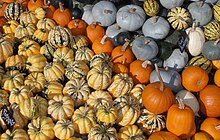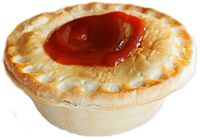Portal:Food
F o o d
A portal dedicated to food and foodways
Introduction


Food is any substance consumed by an organism for nutritional support. Food is usually of plant, animal, or fungal origin and contains essential nutrients such as carbohydrates, fats, proteins, vitamins, or minerals. The substance is ingested by an organism and assimilated by the organism's cells to provide energy, maintain life, or stimulate growth. Different species of animals have different feeding behaviours that satisfy the needs of their metabolisms and have evolved to fill a specific ecological niche within specific geographical contexts.
Omnivorous humans are highly adaptable and have adapted to obtain food in many different ecosystems. Humans generally use cooking to prepare food for consumption. The majority of the food energy required is supplied by the industrial food industry, which produces food through intensive agriculture and distributes it through complex food processing and food distribution systems. This system of conventional agriculture relies heavily on fossil fuels, which means that the food and agricultural systems are one of the major contributors to climate change, accounting for as much as 37% of total greenhouse gas emissions. (Full article...)
Cooking, also known as cookery or professionally as the culinary arts, is the art, science and craft of using heat to make food more palatable, digestible, nutritious, or safe. Cooking techniques and ingredients vary widely, from grilling food over an open fire, to using electric stoves, to baking in various types of ovens, reflecting local conditions. Cooking is an aspect of all human societies and a cultural universal.
Preparing food with heat or fire is an activity unique to humans. Archeological evidence of cooking fires from at least 300,000 years ago exists, but some estimate that humans started cooking up to 2 million years ago.
The expansion of agriculture, commerce, trade, and transportation between civilizations in different regions offered cooks many new ingredients. New inventions and technologies, such as the invention of pottery for holding and boiling of water, expanded cooking techniques. Some modern cooks apply advanced scientific techniques to food preparation to further enhance the flavor of the dish served. (Full article...)
Falafel (/fəˈlɑːfəl/; Arabic: فلافل, [fæˈlæːfɪl] ⓘ) is a deep-fried ball or patty-shaped fritter of Egyptian origin, featuring in Middle Eastern cuisine, particularly Levantine cuisines, and is made from broad beans, ground chickpeas, or both.
Falafel is often served in a pita, samoon, laffa, or wrapped in a flatbread known as taboon; "falafel" also frequently refers to a wrapped sandwich that is prepared in this way. The falafel balls may be topped with salads, pickled vegetables, and hot sauce, and drizzled with tahini-based sauces. Falafel balls may also be eaten alone as a snack or served as part of a meze tray (assortment of appetizers). (Full article...)
Selected article –

Meat is animal tissue, often muscle, that is eaten as food. Humans have hunted and farmed other animals for meat since prehistory. The Neolithic Revolution allowed the domestication of animals, including chickens, sheep, goats, pigs, horses, and cattle, starting around 11,000 years ago. Since then, selective breeding has enabled farmers to produce meat with the qualities desired by producers and consumers.
Meat is mainly composed of water, protein, and fat. Its quality is affected by many factors, including the genetics and nutritional status of the animal involved. It is edible raw, but is normally eaten cooked, such as by stewing or roasting, or processed, such as by smoking or salting. Bacteria and fungi decompose and spoil unprocessed meat within hours or days. (Full article...)Selected cuisine -
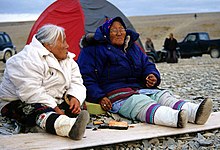
Historically Inuit cuisine, which is taken here to include Greenlandic cuisine, Yup'ik cuisine and Aleut cuisine, consisted of a diet of animal source foods that were fished, hunted, and gathered locally.
In the 20th century the Inuit diet began to change and by the 21st century the diet was closer to a Western diet. After hunting, they often honour the animals' spirit by singing songs and performing rituals. Although traditional or country foods still play an important role in the identity of Inuit, much food is purchased from the store, which has led to health problems and food insecurity. According to Edmund Searles in his article Food and the Making of Modern Inuit Identities, they consume this type of diet because a mostly meat diet is "effective in keeping the body warm, making the body strong, keeping the body fit, and even making that body healthy". (Full article...)Selected ingredient –
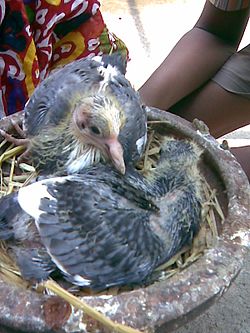
In culinary terminology, squab is an immature domestic pigeon, typically under four weeks old, or its meat. Some authors describe it as tasting like dark chicken.
The word "squab" probably comes from Scandinavia; the Swedish word skvabb means "loose, fat flesh". The term formerly applied to all dove and pigeon species (such as the wood pigeon, the mourning dove, the extinct-in-the-wild socorro dove, and the now extinct passenger pigeon,) and their meat. More recently, squab meat comes almost entirely from domesticated pigeons. The meat of dove and pigeon gamebirds hunted primarily for sport is rarely called "squab". (Full article...)
Selected recipe –
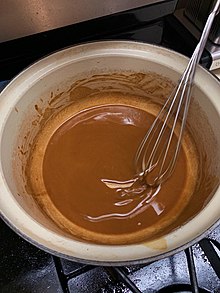
Roux (/ruː/) is a mixture of flour and fat cooked together and used to thicken sauces. Roux is typically made from equal parts of flour and fat by weight. The flour is added to the melted fat or oil on the stove top, blended until smooth, and cooked to the desired level of brownness. A roux can be white, blond (darker) or brown. Butter, bacon drippings or lard are commonly used fats. Roux is used as a thickening agent for gravy, sauces, soups and stews. It provides the base for a dish, and other ingredients are added after the roux is complete. (Full article...)
Cucurbita (Latin for 'gourd') is a genus of herbaceous fruits in the gourd family, Cucurbitaceae (also known as cucurbits or cucurbi), native to the Andes and Mesoamerica. Five edible species are grown and consumed for their flesh and seeds. They are variously known as squash, pumpkin, or gourd, depending on species, variety, and local parlance. Other kinds of gourd, also called bottle-gourds, are native to Africa and belong to the genus Lagenaria, which is in the same family and subfamily as Cucurbita, but in a different tribe. These other gourds are used as utensils or vessels, and their young fruits are eaten much like those of the Cucurbita species.
Most Cucurbita species are herbaceous vines that grow several meters in length and have tendrils, but non-vining "bush" cultivars of C. pepo and C. maxima have also been developed. The yellow or orange flowers on a Cucurbita plant are of two types: female and male. The female flowers produce the fruit and the male flowers produce pollen. Many North and Central American species are visited by specialist bee pollinators, but other insects with more general feeding habits, such as honey bees, also visit. (Full article...)Selected image –
Selected biography –
B. August 15, 1912 – d. August 13, 2004
Julia Carolyn Child (née McWilliams; August 15, 1912 – August 13, 2004) was an American chef, author, and television personality. She is recognized for bringing French cuisine to the American public with her debut cookbook, Mastering the Art of French Cooking, and her subsequent television programs, the most notable of which was The French Chef, which premiered in 1963. (Full article...)
Did you know (auto-generated) –

- ... that the 2020 documentary film Gather, which explores Native American efforts for food sovereignty and reclamation of ancestral foodways, was named a Critic's Pick by The New York Times?
- ... that Kenneth Lo was called "the foremost expert in Britain on Chinese food"?
- ... that a British supermarket uses barriers to prevent shoppers grabbing food with yellow discount stickers out of the hands of staff?
- ... that after George Alexander Albrecht collapsed when conducting Beethoven's Ninth Symphony during a New Year's concert, he returned to composing and began hospice work?
- ... that food stylist Susan Spungen estimated that she baked hundreds of pies with Josh Brolin and film staff while practicing for a scene in Labor Day?
- ... that an investigation found that most Mexican nutrition science students could not interpret a nutritional front-of-package labeling system correctly?
More did you know –
Related portals
Food topics
The following are topics relating to food
Categories
Food list articles
- See also: Lists of foods and Category:Lists of drinks
The following are some Food list articles on Wikipedia:

- American cheeses
- Appellation d'Origine Contrôlée cheeses
- Apple cultivars
- Bacon dishes
- Bacon substitutes
- Basil cultivars
- Breads
- Breakfast beverages
- Breakfast cereals
- Breakfast foods
- British cheeses
- Cakes
- Candies
- Cheeses
- Cheese soups
- Christmas dishes (list)
- Cocktails
- Cookies
- Dishes using coconut milk
- Diets
- Doughnut varieties
- Egg dishes
- Fermented soy products
- Food additives
- Food additives (Codex Alimentarius)
- Foods named after people
- French cheeses
- French dishes
- Fried dough foods
- Fruits
- List of hamburgers
- Herbs and spices
- Hors d'oeuvre
- Indian dishes
- Indian snack foods
- Indonesian dishes
- Italian dishes
- Japanese snacks
- Japanese dishes
- Jewish dishes
- Kebabs
- Korean beverages
- Mango cultivars
- Moroccan dishes
- Pasta
- Pastries
- Philippine snack food
- Pies, tarts and flans
- Poppy seed pastries and dishes
- Potato dishes
- Puddings
- Raw fish dishes
- Rice dishes
- Rolled foods
- Sauces
- Seafood
- Seeds
- Sandwiches
- Snack foods
- Soft drinks by country
- Soul foods and dishes
- Soups
- Stews
- Street foods
- Tapas
- Turkish dishes
- Twice-baked foods
- Vegetable oils
- Vegetables
- Vodkas
Things you can do
Related WikiProjects
| Parent project: WikiProject Food and Drink | |
| Child projects: | Task forces: (All inactive) |
|
|
| Related projects: | |
New articles
Rules | Match log | Results page (for watching) | Last updated: 2024-05-07 19:23 (UTC)
Note: The list display can now be customized by each user. See List display personalization for details.
- Nikolay Vereshchagin (edit | talk | history | links | watch | logs | tools) by Kolya Muratov (talk · contribs · new pages (4)) started on 2024-05-07, score: 10
- Cardinal slice (edit | talk | history | links | watch | logs | tools) by Pek (talk · contribs · new pages (15)) started on 2024-05-07, score: 10
- Big Potato Man (edit | talk | history | links | watch | logs | tools) by B3251 (talk · contribs · new pages (30)) started on 2024-05-06, score: 10
- 2024–25 West Ham United F.C. season (edit | talk | history | links | watch | logs | tools) by Egghead06 (talk · contribs · new pages (1)) started on 2024-05-06, score: 10
- Tarte à l'badrée (edit | talk | history | links | watch | logs | tools) by Frankserafini87 (talk · contribs · new pages (6)) started on 2024-05-06, score: 20
- Café Avole (edit | talk | history | links | watch | logs | tools) by Another Believer (talk · contribs · new pages (86)) started on 2024-05-05, score: 10
- Subric (edit | talk | history | links | watch | logs | tools) by Frankserafini87 (talk · contribs · new pages (6)) started on 2024-05-05, score: 10
- Association of Estonian Food Industry (edit | talk | history | links | watch | logs | tools) by Estopedist1 (talk · contribs · new pages (6)) started on 2024-05-05, score: 20
- Ghost Note Coffee (edit | talk | history | links | watch | logs | tools) by Another Believer (talk · contribs · new pages (86)) started on 2024-05-05, score: 10
- Integrated Aqua-Vegeculture System (edit | talk | history | links | watch | logs | tools) by Wiki142B (talk · contribs · new pages (1)) started on 2024-05-05, score: 10
- Bark City BBQ (edit | talk | history | links | watch | logs | tools) by Another Believer (talk · contribs · new pages (86)) started on 2024-05-04, score: 10
- Fava (Greek dish) (edit | talk | history | links | watch | logs | tools) by Lambiam (talk · contribs · new pages (7)) started on 2024-05-04, score: 20
- Mian Nadeem Riaz (edit | talk | history | links | watch | logs | tools) by HRShami (talk · contribs · new pages (11)) started on 2024-05-03, score: 10
- Šumienkový zákusok (edit | talk | history | links | watch | logs | tools) by Aaa000000 (talk · contribs · new pages (4)) started on 2024-05-03, score: 20
- Pudingový koláč (edit | talk | history | links | watch | logs | tools) by Aaa000000 (talk · contribs · new pages (4)) started on 2024-05-03, score: 20
- Michelle Yoo (edit | talk | history | links | watch | logs | tools) by DrThneed (talk · contribs · new pages (22)) started on 2024-05-02, score: 10
- 2009 Peanut Corporation of America recall (edit | talk | history | links | watch | logs | tools) by Isochrone (talk · contribs · new pages (1)) started on 2024-05-02, score: 10
- Biscuit warmer (edit | talk | history | links | watch | logs | tools) by Wallclockticking (talk · contribs · new pages (5)) started on 2024-05-02, score: 10
- Meat jobber (edit | talk | history | links | watch | logs | tools) by GobsPint (talk · contribs · new pages (69)) started on 2024-05-02, score: 10
- Genevoise sauce (edit | talk | history | links | watch | logs | tools) by Frankserafini87 (talk · contribs · new pages (6)) started on 2024-05-02, score: 10
- Meat broker (edit | talk | history | links | watch | logs | tools) by GobsPint (talk · contribs · new pages (69)) started on 2024-05-02, score: 10
- Kolkata biryani (edit | talk | history | links | watch | logs | tools) by খাঁ শুভেন্দু (talk · contribs · new pages (1)) started on 2024-05-02, score: 10
- Branch house (building) (edit | talk | history | links | watch | logs | tools) by GobsPint (talk · contribs · new pages (69)) started on 2024-05-02, score: 20
- Walnut cake with egg yolk glaze (edit | talk | history | links | watch | logs | tools) by Aaa000000 (talk · contribs · new pages (4)) started on 2024-05-01, score: 20
- Chandamour (edit | talk | history | links | watch | logs | tools) by Alenglin (talk · contribs · new pages (3)) started on 2024-05-01, score: 20
- Tac/Quila (edit | talk | history | links | watch | logs | tools) by Another Believer (talk · contribs · new pages (86)) started on 2024-05-01, score: 10
- Underage club (edit | talk | history | links | watch | logs | tools) by Wallclockticking (talk · contribs · new pages (5)) started on 2024-05-01, score: 10
- Museum of Toruń Gingerbread (edit | talk | history | links | watch | logs | tools) by Dnaoro (talk · contribs · new pages (3)) started on 2024-05-01, score: 20
- Murau Brewery (edit | talk | history | links | watch | logs | tools) by 0Lucky Luke (talk · contribs · new pages (1)) started on 2024-05-01, score: 10
- Esther Choi (edit | talk | history | links | watch | logs | tools) by MemeDab99 (talk · contribs · new pages (3)) started on 2024-04-30, score: 10
- Greens powder (edit | talk | history | links | watch | logs | tools) by Psywave (talk · contribs · new pages (1)) started on 2024-04-30, score: 10
- Koffi (restaurant) (edit | talk | history | links | watch | logs | tools) by Another Believer (talk · contribs · new pages (86)) started on 2024-04-30, score: 10
- H. Avard Loomer (edit | talk | history | links | watch | logs | tools) by B3251 (talk · contribs · new pages (30)) started on 2024-04-30, score: 10
- Sherman's Deli & Bakery (edit | talk | history | links | watch | logs | tools) by Another Believer (talk · contribs · new pages (86)) started on 2024-04-30, score: 10
- Paul B. Wishart (edit | talk | history | links | watch | logs | tools) by Dmarsch (talk · contribs · new pages (6)) started on 2024-04-29, score: 10
- Meat water holding capacity (edit | talk | history | links | watch | logs | tools) by GobsPint (talk · contribs · new pages (69)) started on 2024-04-29, score: 10
- Meat diaper (edit | talk | history | links | watch | logs | tools) by GobsPint (talk · contribs · new pages (69)) started on 2024-04-29, score: 20
- Localis (restaurant) (edit | talk | history | links | watch | logs | tools) by Another Believer (talk · contribs · new pages (86)) started on 2024-04-29, score: 10
- Kōki Saitō (edit | talk | history | links | watch | logs | tools) by Cynikles (talk · contribs · new pages (1)) started on 2024-04-29, score: 10
- 24 in 24: Last Chef Standing (edit | talk | history | links | watch | logs | tools) by TristanQuinn (talk · contribs · new pages (1)) started on 2024-04-29, score: 10
- La Mejor Bakery (edit | talk | history | links | watch | logs | tools) by BaduFerreira (talk · contribs · new pages (11)) started on 2024-04-29, score: 20
- Wilson Davis (edit | talk | history | links | watch | logs | tools) by Vycl1994 (talk · contribs · new pages (20)) started on 2024-04-28, score: 10
- Sweet Rose Creamery (edit | talk | history | links | watch | logs | tools) by TrademarkedTWOrantula (talk · contribs · new pages (5)) started on 2024-04-28, score: 10
- Hunters Palm Springs (edit | talk | history | links | watch | logs | tools) by Another Believer (talk · contribs · new pages (86)) started on 2024-04-28, score: 10
- Haitian spaghetti (edit | talk | history | links | watch | logs | tools) by Valereee (talk · contribs · new pages (4)) started on 2024-04-27, score: 10
- Artocarpus styracifolius (edit | talk | history | links | watch | logs | tools) by Ulathijau (talk · contribs · new pages (2)) started on 2024-04-27, score: 10
- Atomo (edit | talk | history | links | watch | logs | tools) by White 720 (talk · contribs · new pages (2)) started on 2024-04-27, score: 30
- Lauren Rudolph E. coli case (edit | talk | history | links | watch | logs | tools) by Margaretdonnelly (talk · contribs · new pages (1)) started on 2024-04-23, score: 10
- Ruditapes philippinarum (edit | talk | history | links | watch | logs | tools) by Sjl197 (talk · contribs · new pages (1)) started on 2024-04-27, score: 10
- Bonèt (edit | talk | history | links | watch | logs | tools) by Frankserafini87 (talk · contribs · new pages (6)) started on 2024-04-26, score: 20
- Ganmianpi (edit | talk | history | links | watch | logs | tools) by Iuliusnanus (talk · contribs · new pages (20)) started on 2024-04-25, score: 10
- D'Ambrosio Gelato (edit | talk | history | links | watch | logs | tools) by Another Believer (talk · contribs · new pages (86)) started on 2024-04-25, score: 10
- Murcian meat pie (edit | talk | history | links | watch | logs | tools) by ChampClancy (talk · contribs · new pages (1)) started on 2024-04-24, score: 20
- Full Tilt Ice Cream (edit | talk | history | links | watch | logs | tools) by Another Believer (talk · contribs · new pages (86)) started on 2024-04-24, score: 10
- Roger Hugo (edit | talk | history | links | watch | logs | tools) by NouveauSarfas (talk · contribs · new pages (2)) started on 2024-04-24, score: 10
- Gelatiamo (edit | talk | history | links | watch | logs | tools) by Another Believer (talk · contribs · new pages (86)) started on 2024-04-24, score: 10
- Paratrophis banksii (edit | talk | history | links | watch | logs | tools) by Tom Radulovich (talk · contribs · new pages (144)) started on 2024-04-23, score: 10
- Dumb bread (edit | talk | history | links | watch | logs | tools) by LittleT889 (talk · contribs · new pages (9)) started on 2024-04-23, score: 10
- Frankie & Jo's (edit | talk | history | links | watch | logs | tools) by Another Believer (talk · contribs · new pages (86)) started on 2024-04-23, score: 10
- List of food and drink monuments (edit | talk | history | links | watch | logs | tools) by Altenmann (talk · contribs · new pages (61)) started on 2024-04-23, score: 20
- Ko Omm (edit | talk | history | links | watch | logs | tools) by Sattwaikyaw (talk · contribs · new pages (1)) started on 2024-04-22, score: 10
Associated Wikimedia
The following Wikimedia Foundation sister projects provide more on this subject:
-
Commons
Free media repository -
Wikibooks
Free textbooks and manuals -
Wikidata
Free knowledge base -
Wikinews
Free-content news -
Wikiquote
Collection of quotations -
Wikisource
Free-content library -
Wikiversity
Free learning tools -
Wiktionary
Dictionary and thesaurus























